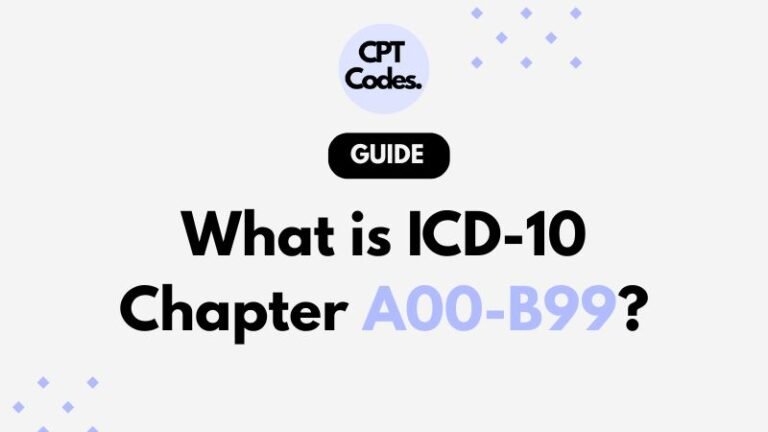ICD-10 codes in the range A00 to B99 cover “Certain Infectious and Parasitic Diseases.”
These are illnesses caused by bacteria, viruses, fungi, or parasites. The classification helps doctors, hospitals, and public health systems identify, track, and report communicable diseases accurately.
Why This Chapter Matters
- It organizes all major communicable and parasitic diseases under one chapter for clarity and global consistency.
- It allows precise medical coding by dividing conditions into smaller groups like intestinal infections, viral diseases, or helminth infections.
- It guides how to record and sequence codes, including identifying the organism responsible or marking drug resistance.
- It helps public health authorities monitor outbreaks, track trends, and plan resources for disease prevention and control.
Structure of Chapter A00–B99
The chapter is divided into clear sections that group diseases by cause or transmission type. Below is an overview:
| Code Range | Disease Group |
|---|---|
| A00–A09 | Intestinal infectious diseases (e.g., cholera, typhoid, salmonella) |
| A15–A19 | Tuberculosis |
| A20–A28 | Zoonotic bacterial diseases (transmitted from animals to humans) |
| A30–A49 | Other bacterial diseases (e.g., leprosy, diphtheria, streptococcal infections) |
| A50–A64 | Sexually transmitted infections (syphilis, gonorrhea, etc.) |
| A65–A69 | Other spirochetal diseases (e.g., leptospirosis) |
| A70–A74 | Diseases caused by Chlamydia |
| A75–A79 | Rickettsioses and related conditions |
| A80–A89 | Viral and prion infections of the central nervous system (e.g., polio, rabies) |
| A90–A99 | Arthropod-borne viral fevers and viral hemorrhagic fevers (e.g., dengue) |
| B00–B09 | Viral infections of skin and mucous membranes (e.g., herpes, chickenpox) |
| B10–B34 | Other viral diseases (e.g., hepatitis, HIV) |
| B35–B49 | Mycoses (fungal infections) |
| B50–B64 | Protozoal diseases (e.g., malaria) |
| B65–B83 | Helminth infections (parasitic worms) |
| B85–B89 | Infestations (lice, mites, etc.) |
| B90–B94 | Sequelae or long-term effects of infectious diseases |
| B95–B97 | Codes for infectious agents and organisms (used with other chapters) |
| B99 | Other and unspecified infectious diseases |
Not every infection appears in this chapter—some, such as influenza or pregnancy-related infections, are coded elsewhere in ICD-10.
Key Coding Guidelines
To use codes from Chapter A00–B99 accurately, medical coders and clinicians should follow a few essential rules:
-
Code only confirmed diagnoses
Except in a few specific cases (like HIV), only confirmed infectious diseases should be coded. -
Sequence correctly
When a patient is admitted because of an HIV-related illness, the HIV code is listed first, followed by the related condition. -
Identify the causative organism
Use additional codes from B95–B97 to specify the bacteria or virus responsible for the infection when necessary. -
Record drug resistance
Use Z16 codes or related codes to indicate antimicrobial resistance (such as MRSA). -
Add sequela codes when needed
If a disease has long-term consequences—like paralysis after polio—use sequela codes from B90–B94. -
Follow Excludes notes
Certain infections are excluded from this chapter and must be coded under other categories, depending on the affected body system or condition.
Common Examples in Chapter A00–B99
- Cholera (A00): Severe diarrheal illness caused by Vibrio cholerae.
- Typhoid fever (A01): Systemic infection due to Salmonella Typhi.
- Tuberculosis (A15–A19): Includes pulmonary, disseminated, and extrapulmonary TB.
- HIV disease (B20–B24): Covers HIV infection and associated conditions.
- Viral hepatitis (B15–B19): Includes hepatitis A, B, C, D, and E—acute or chronic.
- Malaria (B50–B54): Protozoal infection caused by Plasmodium species.
- Schistosomiasis (B65): Parasitic infection caused by flatworms.
- Late effects of poliomyelitis (B91): Paralysis or other long-term complications following polio infection.
Key Takeaway
ICD-10 Chapter A00–B99 plays a vital role in medical documentation and disease tracking. It standardizes the way infectious and parasitic diseases are coded worldwide—supporting everything from hospital billing to international health statistics.

